ISSN ONLINE(2319-8753)PRINT(2347-6710)
ISSN ONLINE(2319-8753)PRINT(2347-6710)
Mahesh.V.M1, B.K.Muralidhara2, Raji George3
|
| Related article at Pubmed, Scholar Google |
Visit for more related articles at International Journal of Innovative Research in Science, Engineering and Technology
In the present work, the hybrid nanomaterial such as Graphene-Multiwalled Carbon Nanotube reinforced epoxy composites are fabricated with different weight fraction of the reinforcement and are subjected to hardness test as well as tensile test. The mechanical properties of these composites are investigated and found posses increase in hardness and young’s modulus with increased weight fraction of the reinforcement compared to the based matrix fabricated using the same process.
Keywords |
| Epoxy resin, graphene, hardner, multiwalled carbon nanotube, nanocomposites. |
INTRODUCTION |
| Graphene and Carbon nano-tubes is the form of carbon, Graphene appears as thin, transparent and one atom thick, multiwalled carbon nanotubes (MWCNT’s) is rolled to a tubular shape with multiple layers. MWCNT’s are to revolutionize several fields in mechanical and electrical engineering. These are a major component of nanotechnology. Graphene and MWCNT have a wide range of unexplored potential applications in various technological areas, Mechanical strengths such as electrostatic paintings, adhesives, aircraft parts, sports goods, coatings etc., electrical components, etc., |
| Epoxy-based composite materials are used as structural components not only in weight sensitive aerospace industry, but also in the marine, armour, automobile, railways, structural engineering to their excellent high-adhesion, lowweight and good chemical/corrosion-resistance. |
| Over the years, many attempts have made to modify epoxy by adding nanomaterial to improve the matrix-dominated composite properties. The addition of nanomaterial improves the Young`s modulus and strength of epoxy.[1] |
| These properties would enable us the specific application for which the specimens can be tailor-made. Applications are of conductive polymers, composites in electronic, automobile products, as sensors, instruments in applications like microscope probe tips, gas leak detectors, electromagnetic shielding sporting goods (tennis racket), as conductive coatings in printed circuit board, as catalysts in petrochemical applications, as textiles, fibers, in lithium ion batteries, lamps, semiconducting materials, advanced ceramics, microwave antennas, medical implants, drug delivery, aerospace etc. |
| The earliest method for the graphene-carbon nanotube production is the electric arc discharge[2][3]. This technique was used already in the early sixties by R. Bacon for the synthesis of graphene-carbon nanotube. The same technique was adapted in 1990 by Kratschmer and Huffman to produce fullerenes in good yields, and later on this method was improved, applied for the synthesis of graphene, multiwalled carbon nanotube (MWCNT) and single walled carbon nanotube (SWCNT). Other methods such as the laser evaporation/ablation and chemical vapour deposition (CVD) were also successfully examined in the production of carbon nanotube. The laser evaporation process is technically similar to the arc discharge method. The difference between these two methods is in the quality and purity of the obtained products. However, the arc discharge and the different types of CVD are the most promising and utilized techniques in the large scale production of carbon nanotube and related materials. Here, in this investigation we use Arc Discharge method. |
| Nanotube was observed in 1991 in the carbon soot of graphite electrodes during an arc discharge, by using a current of 100 amps that was intended to produce fullerenes. However the first macroscopic production of carbon nanotubes was made in 1992 by two researchers at NEC's Fundamental Research Laboratory. The method used was the same as in 1991. During process, carbon contained in negative electrode sublimates, because of high-discharge temperature and also nanotubes were initially discovered using this technique, it has been the most widely used method of nanotube synthesis. The yield for this method is up to 30% by weight and it produces both single-walled and multi-walled nanotubes with lengths of up to 50 micrometers with few structural defects[4][5]. |
| The arc discharge technique generally involves the use of two high-purity graphite electrodes. The anode is either pure graphite or contains metals. In the latter case, the metals are mixed with the graphite powder and introduced in a hole made in the anode centre. The electrodes are momentarily brought into contact and an arc is struck. The synthesis is carried out at low pressure (30-130 torr or 500 torr) in controlled atmosphere composed of inert and/or reactant gas. The distance between the electrodes is reduced until the flowing of a current (50–150 A). |
| The temperature in the inter-electrode zone is so high that carbon sublimes from the positive electrode (anode) that is consumed. A constant gap between the anode and cathode is maintained by adjusting the position of the anode. A plasma is formed between the electrodes. The plasma can be stabilized for a long reaction time by controlling the distance between the electrodes by means of the voltage (25–40 V) control. The reaction time varies from 30–60 seconds to 2–10 minutes[6][7].c |
EXPERIMENTAL SECTION |
Material |
| The polymer matrix consisted of bisphenol-A-based epoxy resin (Araldite GY LY556) with an amine-based hardener (Aradur HY 917), obtained from Huntsman Advanced Materials and Ethanol was the chosen solvent. Graphene-Multiwalled carbon nanotubes produced by arc discharge were supplied by NANOSHELL Wilmington DE USA and its purity was higher than 98% (information taken from the supplier data sheet). |
Preparation of Graphene-MWCNT/Epoxy Composite |
| Graphene-MWCNT was mixed with ethanol and sonicated for 15 minutes in a beaker. The sonication helps disperse the nanoparticles uniformly and reduce lumps, thus countering the Vander wall`s forces set up. This procedure helps us in getting fine grained graphene-MWCNT. The above mixture (graphene-MWCNT & ethanol) is heated on an electric heater to evaporate ethanol in the same beaker. Care must be taken to not heat the graphene-MWCNT above 75`C. MWCNT taken in amounts of 0.25%, 0.5%, 0.75%, 1%, 1.25%, 1.5%, 1.75% and 2% weight fraction, epoxy resin and hardener were taken in appropriate weight standards (composition), with respect to the mould used. Graphene-MWCNT and epoxy resin were thoroughly mixed for 30 minutes using sonicator. The sonication is carried out in a water bath thereby lowering the undesired heat which polymerizes the epoxy fluid. The sonication helps to disperse the nanoparticles uniformly throughout the epoxy polymer matrix. Hardener was added to the above mixture (Graphene- MWCNT & epoxy resin) 100:1 and stirred for 5 minutes with a stirrer. The mixture is pre-heated in an electric oven up to 45’C after adding the hardener 10:1. The mixture is heated in a controlled environment in an electric oven, then poured into the die and placed in a Petri dish. It is kept in an atmospheric condition for 12 hrs to cure. |
Procedure for characterization of epoxy polymer powder and Graphene-MWCNT by Scanning Electron Microscope (SEM) |
| On a brass stub, (cylinder of 9mm ïÃÂÃâ having a length of 6 ± 0.5 mm) a double gum carbon conducting tape (of 2mm X5mm) has been carefully stuck. A few milligrams of nanomaterial powder (Graphene-MWCNT) or epoxy polymer powder has been uniformly spread on this stub. To make the Graphene-MWCNT /epoxy polymer powder electrically conducting, this stub has been coated with a thin layer (of 2-3 microns thick) of gold or platinum by physical vapour deposition (PVD) technique. |
| After coating the nano material powder with gold or platinum, the stub has been placed in the specimen holder of the SEM. Required magnification has been chosen and specimen table has been rotated to focus the area of the nanomaterial powder sample. Magnified imaged of the nanomaterial powder has been captured after selecting a particular area and soft copy of the image has been stored in the computer interfaced to the SEM, EDAX pattern of the chosen area of the nano material powder has been acquired. |
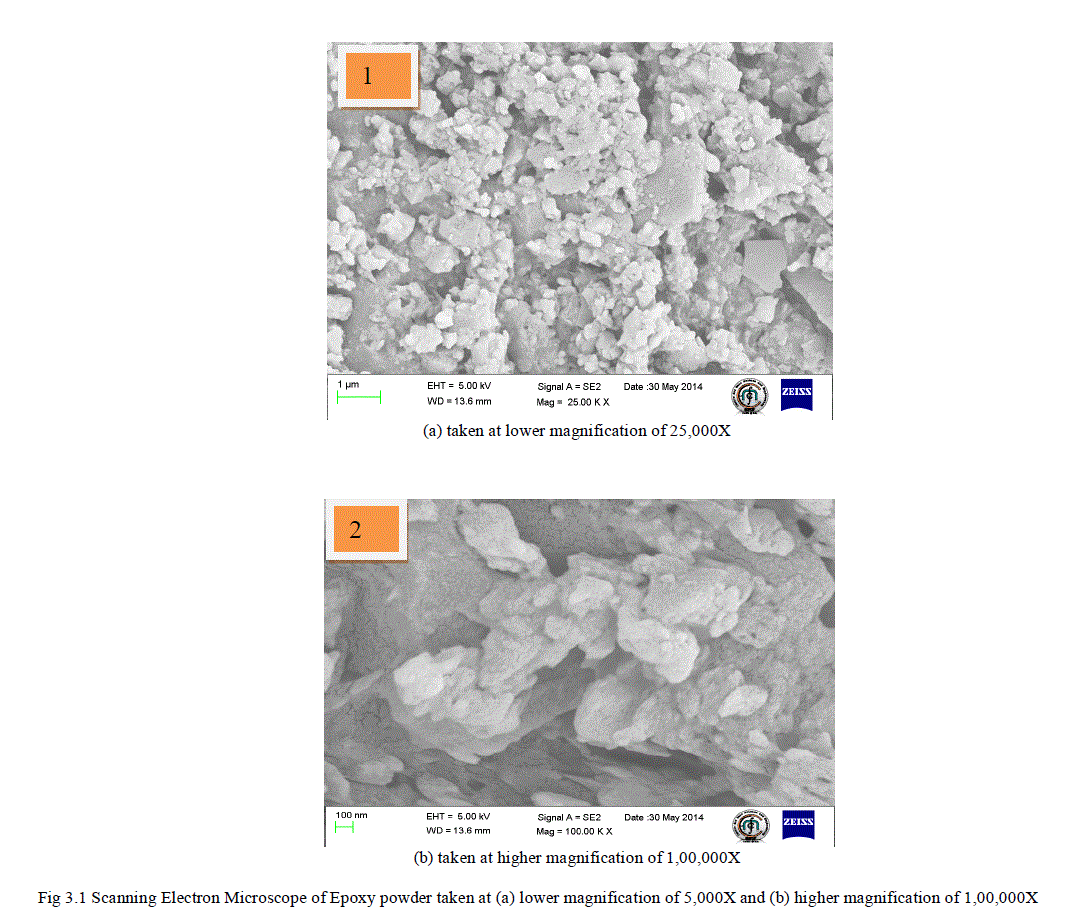 |
| Fig 3.1 Scanning Electron Microscope of Epoxy powder taken at (a) lower magnification of 5,000X and (b) higher magnification of 1,00,000X |
| The scanning electron microscope of Epoxy powder taken at (a) lower magnification of 5,000X and (b) higher magnification of 1,00,000X used in the investigation have been presented in figure 3.1(a) and (b) respectively. From figure 3.1 (a) it may be observed that particles of epoxy powder have irregular shapes. The particles have different sizes. Further it may be observed that epoxy powder contains small irregularly shaped particles taken at 25,000X magnification |
| From figure 3.1 (b) it may be observed that particles of epoxy powder have irregular shapes. The particles have different sizes. Further it may be observed that epoxy powder contains small irregularly shaped particles taken at 1,00,000X magnification. |
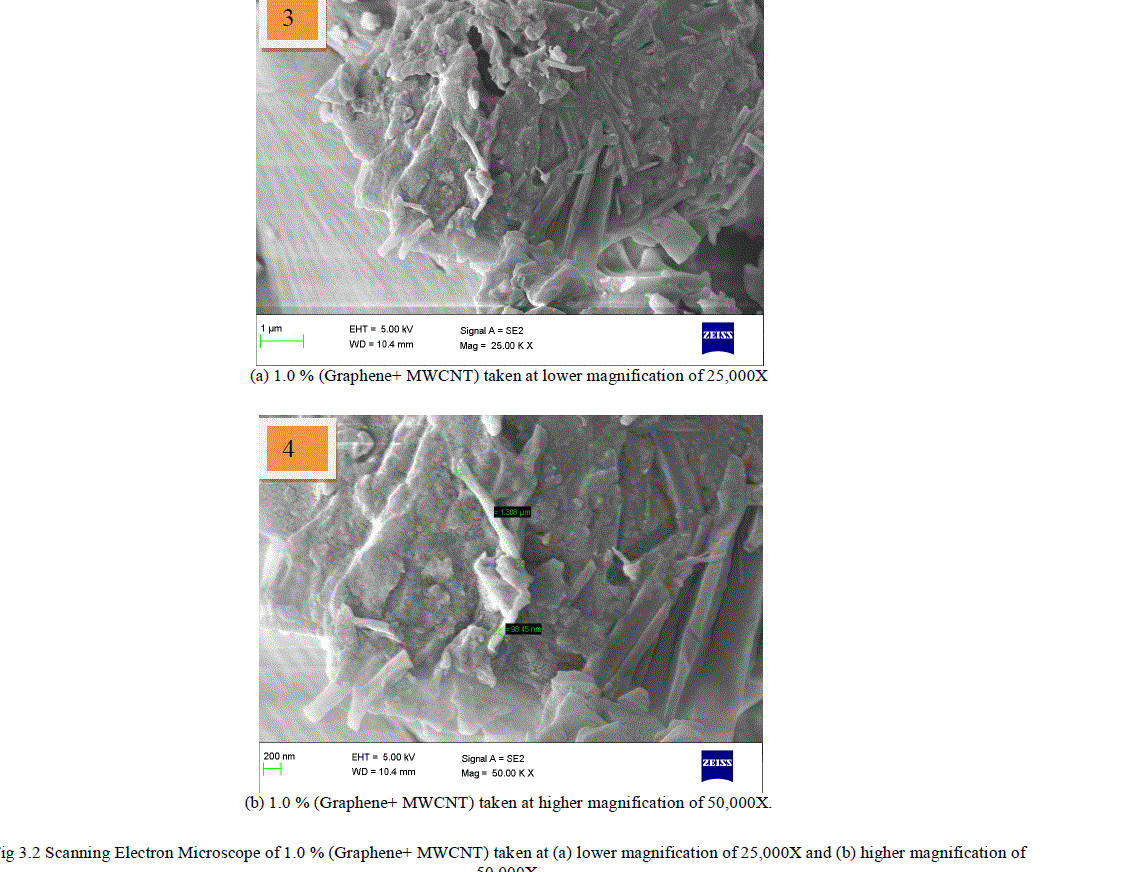 |
| Fig 3.2 Scanning Electron Microscope of 1.0 % (Graphene+ MWCNT) taken at (a) lower magnification of 25,000X and (b) higher magnification of 50,000X. |
| The scanning electron microscope of 1.0 % (Graphene+ MWCNT) taken at (a) lower magnification of 25,000X and (b) higher magnification of 50,000X used in the investigation have been presented in figure 3.2(a) and (b) respectively From figure 3.2 (a) it may be observed that particles of graphene+MWCNT powder have irregular shapes. The particles have different sizes. Further it may be observed that graphene+MWCNT powder contains small irregularly shaped particles taken at 25,000X magnification. The size of a typical large irregularly shaped particle is in the range of 200- 200nm. The size of a typical small irregularly shaped particle is in the range of 20nm- 200nm and is observed that dispersed in the epoxy powder. |
| From figure 3.2 (b) it may be observed that particles of 1.0 % (Graphene+ MWCNT) powder have irregular shapes. The particles have different sizes. Further it may be observed that 1.0 % (Graphene+ MWCNT) powder contains small irregularly shaped particles taken at 50,000X magnification. The size of a typical small irregularly shaped particle is the range of 2nm- 200nm and is observed that dispersed in the epoxy powder. |
RESULTS AND DISCUSSION |
Rockwell Hardness Test |
| The Rockwell test consists of measuring the additional depth to which a carbide ball or diamond penetrator is forced by a heavy (major) load beyond the depth of a previously applied light (minor) load (SET point). |
| Rockwell hardness values are pressed as a combination of a hardness number, a scale symbol representing the indenter, the minor and major loads. The hardness number is expressed by the symbol HR and the scale designation. |
| 1. The indenter moves down into position on the part surface. |
| 2. A minor load is applied and a zero reference position is established |
| 3. The major load is applied for a specific time period (dwell period) beyond zero. |
| 4. The major load is released leaving the minor load applied |
| The resulting Rockwell number represents the difference in depth from the zero reference position as a result of the application of the major load. |
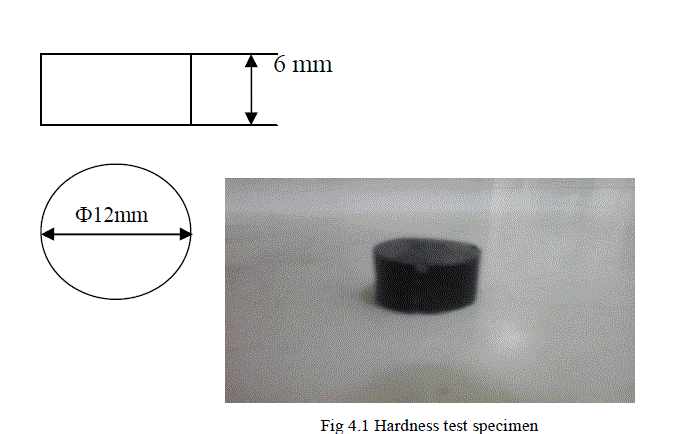 |
| The above figure 4.1 represents the Rockwell hardness specimen dimensions as well as the specimen was prepared according to the ASTM standard ASTM785 |
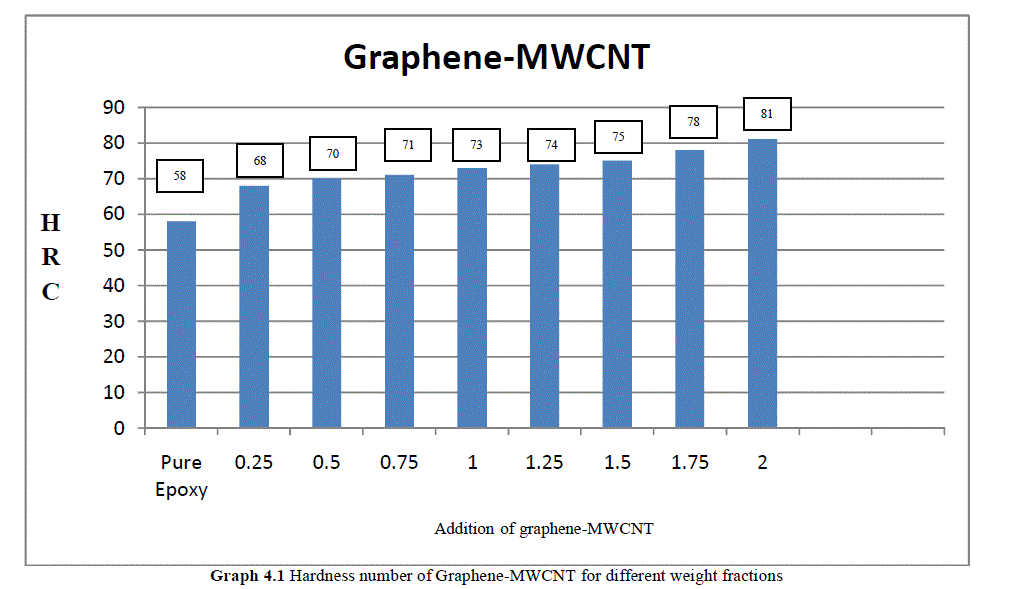 |
4.2Tensile Test |
| A Tensometer is a device used to evaluate the Young's modulus of a material and other tensile properties of materials, such as tensile strength. It is usually loaded with a sample between two grips that are either adjusted manually to apply force to the specimen. The machine works either by driving a screw or by hydraulic ram. Material to be tested must be cut to a specific shape so as to fit the grips, usually in the form of a dog-bone shape. The measurements taken are load and displacement and a tensometer gives directly the load- displacement curve. The specimen is fit between the jaw setup of the tensometer, the load is applied at a velocity of 1 mm/min and then once the test is done i.e. specimen is broken, the Ultimate Tensile Strength in N/mm2, Elongation (%) as well as Proof Stress in N/mm2 is noted down. A minimum of two samples are tested from each composition and the one best nearest readings are considered. Totally a minimum of specimens were prepared for each composition and tested. A total of 16 specimens were tested for all trials. |
 |
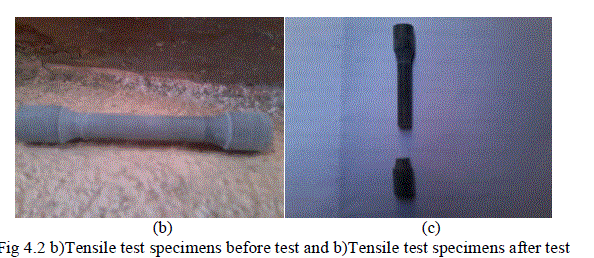 |
CONCLUSION |
| The Graphene-MWCNT/epoxy nanocomposites have been fabricated and the reinforcing effect of graphene-MWCNT been investigated for enhancing the mechanical properties of the epoxy resin. It is shown that the blending of graphene- MWCNT a proper content of 0.25 wt.% into the epoxy matrix can simultaneously enhance the tensile strength, Young’s modulus and Hardness strength. The composite tensile test and hardness test reach the maximum with an improvement of 0.5%, 0.75%, 1.25%, 1.50%, 1.75% and 2.0% for the tensile strength and hardness strength respectively. These are explained mainly in terms of the graphene-MWCNT/epoxy interfacial bonding at room temperature and the dispersion of graphene-MWCNT in the epoxy matrix. Consequently, graphene-MWCNT is a promising nano-modifier for enhancing the mechanical properties of epoxy resins. |
References |
|